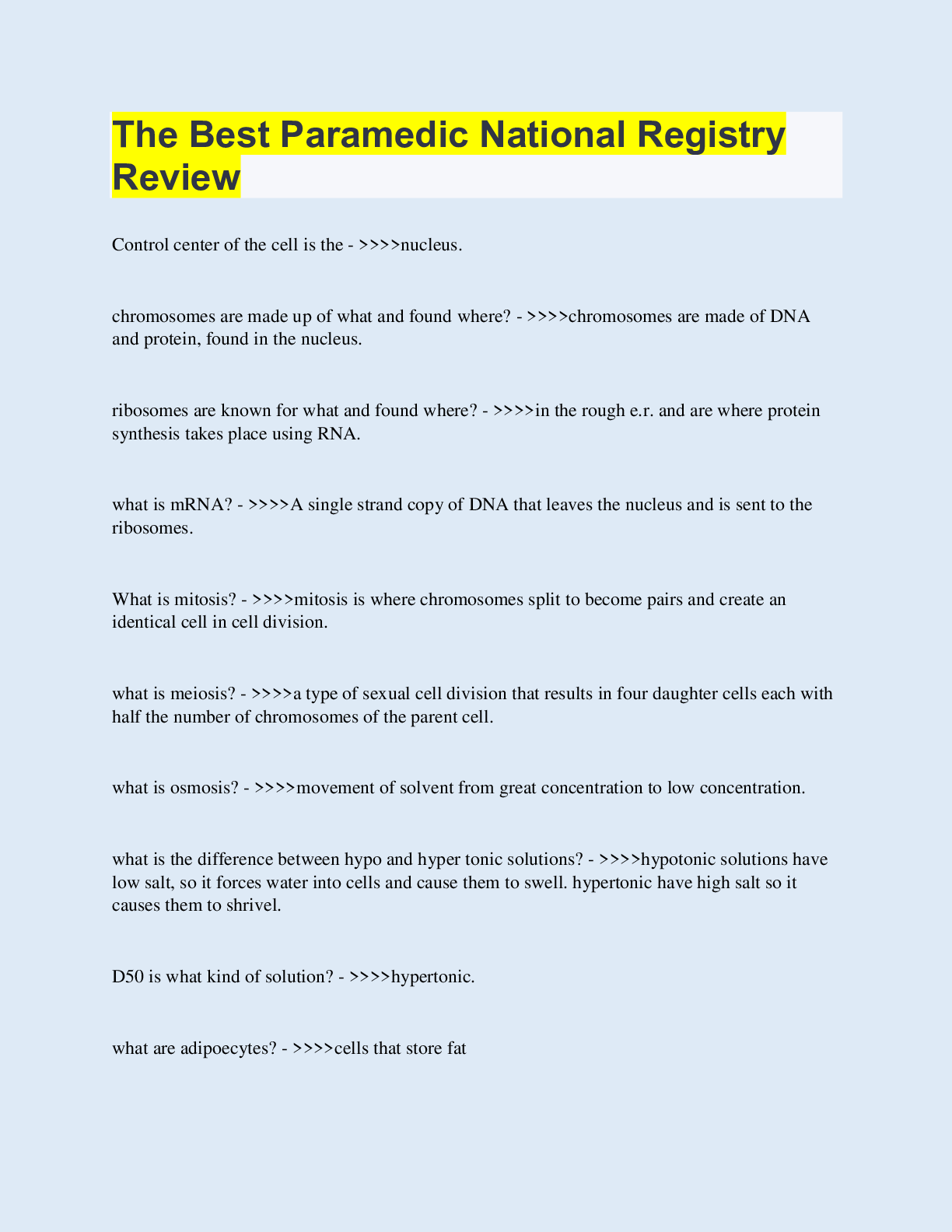Health Care > EXAM > Advanced EMT National Registry Review | Contains 180 Q&A (All)
Advanced EMT National Registry Review | Contains 180 Q&A
Document Content and Description Below
A 27-year-old male complains of an acute onset of abdominal pain. He is found curled in a fetal position with his right knee drawn up into his abdomen, and he has been running a fever for the past twe... lve hours. This patient is most likely suffering from: - ANSWER appendicitis You are called to a 25-year-old man complaining of RLQ pain. His other symptoms are nausea and vomiting, fever, and decreasing pain in the umbilicus area. You should suspect: - ANSWER appendicitis You are called to a residence where a 27-year-old male has just been removed from the building by the fire department. The patient has soot about his nose and mouth. Which of the following is your MOST immediate concern? - ANSWER swelling airway The pathophysiology that ensues from vomiting and diarrhea secondary to Acute Gastroenteritis (AGE) affects every body system. Respiratory symptoms typically include an increase in tidal volume and respiratory rate. This change in respiratory system mechanics is a result of: - ANSWER : Respiratory compensation of metabolic acidosis. All of the following would result in metabolic acidosis, EXCEPT: - ANSWER overdose on antacids A 43-year-old female is unconscious following an overdose of heroin. Her respirations are slow and shallow. Which of the following conditions will she initially develop if not treated? - ANSWER respiratory acidosis During an attempted resuscitation from cardiac arrest, the patient inadvertently receives too much sodium bicarbonate. This would result in: - ANSWER metabolic alkalosis When intubating a small child, how do you measure for the correct sized tube? - ANSWER B: Compare the tube to the diameter of the child's little finger. Your 19 year old male, tall, thin patient experienced chest pain and SOB while playing basketball. You should suspect which of the following: - ANSWER simple pneumothorax Identify the structure located at the division of the trachea into the right and left bronchus. - ANSWER carina Your 24-year-old female asthmatic patient is breathing at 20 times per minute with a tidal volume of 200 ml.What is her minute volume? - ANSWER 4000 ml The volume of air inhaled in a typical breath is the: - ANSWER tidal volume After performing abdominal thrusts, you are still unable to get air into the chest of a suspected choking adult and the patient becomes unresponsive. What is your NEXT action? - ANSWER begin chest compressions You are evaluating a patient with a possible cardiac problem. How would you expect this patient to describe his pain if he was experiencing a myocardial infarction? - ANSWER "I feel pressure right under my breastbone." You are called to the scene of a 47-year-old male with a current chief complaint of chest pain. The patient informs you he has never been sick a day in his life prior to this. Which of the following will provide you the greatest information? - ANSWER OPQRST You have a patient complaining of chest pain. Which of the following would you LEAST likely include in your differential diagnosis? - ANSWER allergic reaction You are called to assess a 57-year-old patient with a primary complaint of chest pain. The pain began while the patient was climbing two flights of stairs and he informs you that he is now pain free, but it took three nitro tablets instead of the usual two for him to have relief. His 12-lead shows no abnormalities now. Which of the following is the MOST appropriate field impression and recommendation for this patient? - ANSWER Unstable angina; transport for further evaluation. Which of the following is the MOST common presenting symptom of acute myocardial infarction in the adult male? - ANSWER chest pain or pressure A 72-year-old female complains of chest pain and trouble breathing. She suddenly vomits and her heart stops beating. What is your FIRST priority? - ANSWER compressions and clearing the airway Which of the choices below best represents the reason we give aspirin to patients we suspect of having a heart attack? - ANSWER platelet aggregation inhibitor. Which of the following dysrhythmias would be MOST commonly seen immediately after a patient goes into cardiac arrest? - ANSWER V fib The MOST common cause of ventricular fibrillation is: - ANSWER myocardial infarction Which of the following is the correct definition of Starling's Law? - ANSWER The more the myocardial muscle is stretched, the greater its force of contraction. You are called to a scene for a patient with difficulty breathing. One of the first questions you ask the patient is, "Mrs. Smith, why did you call for an ambulance today?" Which of the following best classification of your question? - ANSWER open-ended question Which of the following is an example of an open-ended question? - ANSWER "Can you describe your pain?" While completing an EMS run form, you are coaxed to hurry up and finish your prehospital care report so that you may return to the station. Identify the BEST reason for not rushing through the written documentation portion of this call. - ANSWER D: It is our legal means of documenting what and when something occurred during a call. Your patient care report should be filled out completely and accurately before you turn it over to the hospital. Which of the following is the most important reason for adherence to this principle? - ANSWER It will be used to ensure continuity of patient care You respond to a mass casualty incident and one of your patients is alert, coherent and has two bilateral femur fractures. What triage category would be assigned to this patient? - ANSWER Yellow In the pancreas, glucagon is secreted for the purpose of: - ANSWER Stimulates the breakdown of glycogen. Which of the following cells of the pancreas is responsible for the production of glucagon? - ANSWER alpha Which of the following cells of the pancreas is responsible for the production of insulin? - ANSWER beta You are on the scene of a 36-year-old male, Type I diabetic. His wife states he did not eat breakfast this morning after he took his insulin. Assessment of the patient reveals cool and clammy skin, a weak, rapid pulse, a blood sugar of 20, and you are unable to obtain IV access. Treatment for the above patient would include which of the following? - ANSWER Glucagon 1.0 mg IM, and immediate transport. You are called to treat a conscious, disoriented, hypoglycemic patient who is not complaining of dysphagia. Which of the following would be the MOST appropriate management for this patient? - ANSWER administer orange juice Which of the following respiratory patterns is associated with an attempt to compensate for diabetic ketoacidosis? - ANSWER Kussmaul A 32-year-old female, Type I diabetic administered her morning dose of insulin but did not eat. Which of the following would you expect to see in this patient? - ANSWER Hypoglycemia Identify the MOST common assessment findings associated with a patient who is allergic to Hymenoptera stings and is stung by a hornet. - ANSWER Urticaria, wheeziness, difficulty breathing, and laryngeal edema. You have a patient with hives, itching, watery eyes, and a runny nose. He is not complaining of difficulty breathing and his vital signs are normal. Which of the following BEST describes this patient's condition? - ANSWER mild allergic reaction An exaggerated response by cellular immunity of the immune system to a foreign substance is known as which of the following? - ANSWER allergic reaction Which of the following would be the correct dose, concentration, and route of epinephrine for a patient experiencing an allergic reaction with mild dyspnea? - ANSWER 0.3 mg of 1:1,000 SQ. During your assessment of a patient having an allergic reaction, you find out he has a history of some type of heart problem. Which step should be done FIRST for the treatment of his problem today if you were allowed to do any of these skills? - ANSWER Administration of oxygen via a high-concentration device. Which of the following would lead you to suspect that a patient is going to have an allergic or anaphylactic reaction involving swelling of the airway and blood vessel dilation? - ANSWER A second exposure after a previous reactive incident where the body formed antibodies When assessing a patient having an allergic reaction, which of the following should be your HIGHEST priority? - ANSWER lung sounds An exaggerated allergic reaction to a foreign protein or other substance would be the definition of: - ANSWER anaphylaxis When a patient has a history of developing hives following a bee sting, there is a concern with a new sting incident that: - ANSWER Each reaction is worse than the last and could develop into anaphylaxis. You are called to a patient who has urticaria, itching, coughing, and tachycardia after eating shellfish. The patient also states he is having difficulty breathing. Which of the following would you NOT expect to find in the above patient? - ANSWER Hypertension. Which of the following accounts for the largest number of deaths per year from anaphylaxis? - ANSWER Parenteral penicillin. Most often, the initial signs and symptoms of anaphylaxis typically begin within how long following exposure? - ANSWER 30-60 seconds Which of the following is considered the latest finding in anaphylaxis? - ANSWER Bradycardia You are called to treat a patient who is having an anaphylactic reaction to antigen exposure. Which of the following is a LATE sign of the anaphylactic reaction? - ANSWER decrease in blood pressure Which of the following is the MOST serious physical manifestation of anaphylaxis? - ANSWER hypotension Which of the following methods of entry of allergens into a patient will more likely result in anaphylaxis than the other methods of entry? - ANSWER injection Which of these is the proper dose of epinephrine to give to an adult with anaphylaxis? - ANSWER 0.3 to 0.5 mg Where is histamine released from during an allergic response? - ANSWER mast cells What is the primary chemical mediator in an allergic response? - ANSWER Histamine Which of the following mediators is responsible for many of the manifestations of anaphylaxis? - ANSWER Histamine You are called to a local campground for a 28-year-old female stung by a bee. The patient's only complaint is itching. She has urticaria only around the site where she was stung. The patient denies any difficulty breathing and lung sounds are clear and equal. Which of the following is NOT appropriate for the above patient? - ANSWER Epinephrine 0.3 mg SQ. Which of the following would an alcohol based hand sanitizing agent not be effective against? - ANSWER C. Diff When transporting a patient with tuberculosis, a(n) ________ mask should be worn by the EMT and a(n) ________ mask should be worn by the patient. - ANSWER N 95, surgical For which of the following reasons you are legally able to treat a patient who is unconscious? - ANSWER The patient's consent is implied. When you are asking an adult patient if it would be okay for you to assess him and provide care, you are asking for which of the following? - ANSWER expressed consent You are called to the scene of an unresponsive 3-year-old. You have assessed the patient and provided treatment. You next explain the situation fully to the parents and ask them if it would be acceptable if you transported the patient to the nearest hospital. The hospital does not have a pediatric specialist, but you believe this course of action is in the patient's best interest. Which type of consent have you requested? - ANSWER informed consent You are at the scene of a 27-year-old male who is unconscious and EMS was called by his parents. Which of the following type of consent would apply? - ANSWER implied consent A 22 year old with Down's syndrome cut his arm while at work. He has a 2 inch laceration and insists he is fine and does not want to go to hospital. You should: - ANSWER have him sign a refusal and leave You respond to a 68 year old male with chest pain. An individual on-scene identifies himself as a physician and orders you to give an aspirin. What would you do? - ANSWER contact medical control You are working with a paramedic and he wants to perform a procedure that is contraindicated. You should: - ANSWER Advise him it is contraindicated and your concerns You have an unresponsive patient that you started an IV on and the patient wakes up and tears the needle out and refuses to let you start another one. He later dies and the family wants to file a law suit. Based on this situation what legal premise would provide you protection? - ANSWER There was no proximal cause related to his death Which of the following medications would you expect a patient with a history of seizures (epilepsy) to be taking? - ANSWER Phenytoin (Dilantin) Which of the following physiological causes of a seizure would be the MOST alarming yet easily correctable? - ANSWER hypoglycemia You are interviewing the family of a seizure patient. Which of the following answers to your questions should give you the greatest concern? - ANSWER "He has stopped and started seizing three times in a row now." A series of two or more seizures without an intervening period of consciousness defines which of the following? - ANSWER status epileptics You arrive on scene to find an elderly female lying in bed. The family advises you that she is not acting like her normal self. Which of the following would you assess? - ANSWER Have the patient perform an arm drift test, facial droop test, and speak in a sentence. Which of the following set of vital signs would most likely be indicative of a patient with pre-eclampsia? - ANSWER 152/94 Which of the following would be abnormal for a pregnant female in her last trimester of pregnancy? - ANSWER an elevated blood pressure During transport of a pregnant female in her late second trimester, she begins tonic clonic seizure activity. The patient is already on oxygen via non-rebreather and has an IV in place. Referring to the above scenario, what would you expect the patient's blood pressure to be? - ANSWER 180/120 During a breech delivery, the baby's legs and trunk deliver; however, the head does not deliver spontaneously. You should: - ANSWER keep the infant's mouth and nose away from the vaginal wall. You have just placed a 9-month pregnant female on a back board. The patient was stable prior to this and was complaining of back pain. She is now unresponsive, is breathing rapidly, and has a weak, rapid pulse. Which of the following is your MOST immediate priority? - ANSWER tilt the patient on the board to the left side During delivery of a newborn, the umbilical cord becomes wrapped around the neck. Which of the following is the best way to manage this? - ANSWER gently lift the cord over the babies head Where, when, and under what conditions do most accidents involving ambulances occur? - ANSWER At intersections, during the day, and with good road conditions. During the stage of shock when compensatory mechanisms have failed, cells are forced into: - ANSWER aerobic metabolism How are cells able to produce ATP without the presence of oxygen? - ANSWER by using anaerobic metabolism You have an anxious trauma patient with pale, cool, clammy skin and a stable blood pressure of 120/80. His pulse and respirations are rapid. Which of the following BEST classifies this patient? - ANSWER Compensated shock with anaerobic metabolism. The movement of a solute in a solution from an area of higher concentration to an area of lower concentration is called: - ANSWER diffusion Which of these refers to water moving from an area of low concentration across a semi-permeable membrane to an area of high concentration? - ANSWER osmosis Which of the following processes moves sodium out of the cell? - ANSWER sodium potassium pump What is the process that allows oxygen and carbon dioxide to transfer in the alveoli? - ANSWER diffusion Which of the following is the term used to refer to a positively charged ion? - ANSWER cation In the process of movement across a semi-permeable membrane, which of the following processes requires the use of cellular energy? - ANSWER active transport You begin assisting ventilation with supplemental oxygen to a patient that is hypoperfusing. What will result? - ANSWER Hydrogen ions in the body will decrease An EMS provider is trying to determine if all of the organs are being perfused adequately. Which finding would suggest the pediatric patient's perfusion is adequate? - ANSWER Strong peripheral pulses. During treatment of a pediatric pneumonia patient, rescuers notice the patient condition change from respiratory distress to failure. What do you suspect has happened to indicate this change has occurred? - ANSWER The patient's heart rate decreases. All of the following would be expected in a pediatric patient with an airway problem EXCEPT: - ANSWER Increasing heart rate. EMTs from a BLS response agency report to ALS providers that their pediatric patient has been sick for a day or two, and they suspect she has complications from croup. During their assessment of the child, they would expect to find all of the following signs EXCEPT? - ANSWER drooling EMS personnel are treating a 5-year-old with epiglottitis complications. The child is having difficulty breathing, is easily agitated, and is starting to drool. What advice would you offer during transport if you were in charge? - ANSWER Leave the child alone and transport in the mother's arms if comfortable. You are called to the scene of a 5-year-old male who is lethargic and has a temperature of 103 degrees Fahrenheit. Lung sounds are clear, but the child complained of a very sore throat prior to going to bed. During transport, you note copious secretions. Which of the following do you suspect? - ANSWER epiglottis Which of the following would represent the expected systolic blood pressure range for a toddler (3 year old)? - ANSWER 72-100mmHg When caring for an infant, which of the following would concern you the greatest? - ANSWER heart rate for 60 Which of the following indicates an immediate need for chest compressions in a newborn? - ANSWER heart rate less than 60 You are called to assess a four-year-old child with a fever. The child is also complaining of a headache and stiff neck. The child is covered with a large, purple rash on the face. The child has a history of a ventriculoperitoneal shunt. - ANSWER Meningitis. You have a 2 year old child which was electrocuted due to an electrical outlet. He is apneic with a heart rate of 80. What should you do? - ANSWER Ventilate at 20 breaths per minute via BVM Which of the following is the leading cause of accidental death in all children over one year of age? - ANSWER MVCs Pediatric patients found in cardiac arrest are usually in arrest as a result of: - ANSWER Complications from breathing problems. Which of the following statements is TRUE regarding the epidemiology of SIDS? - ANSWER It is the leading cause of death among infants less than 1 year old. A 4 year old fell from the monkey bars at a playground. What are components of the pediatric assessment triangle you would use to quickly assess the child? - ANSWER C: Appearance, work of breathing and circulation. A babysitter explains she witnessed a child seizing and called 911 a minute after it started. What is the MOST common cause for a child to have a convulsion? - ANSWER high temp Which of the following is the primary reason we give nitro to patients we think are having a heart attack?A: For its analgesic properties. - ANSWER For its potent vasodilator properties. Nitroglycerin accomplishes which of the following in the setting of congestive heart failure? - ANSWER Decreases venous return. Which of the following is another name for aspirin? - ANSWER Acetylsalicylic acid A 60-year-old female complains of nausea and back/jaw pain. She has been prescribed nitroglycerin in the past. Select the assessment that would be a contraindication for assisting with administration of nitro. - ANSWER blood pressure 88/42 Giving too much of a fluid bolus in a hypovolemic patient can result in which of the following: - ANSWER Hemodilution Which of the choices below best represents the reason we give aspirin to patients we suspect of having a heart attack? - ANSWER Platelet aggregation inhibitor. Which of the following would be a method to calm a patient with a behavioral emergency? - ANSWER take your time and listen to hum Which of the following would be appropriate when dealing with a patient with a behavioral emergency? - ANSWER Maintain contact with the patient. A patient who requires restraints is always: - ANSWER transported in supine position Encountered with a patient with a large chemical powder exposure, the correct treatment intervention would be: - ANSWER Brushing off chemical, disrobing, and treatment per signs and symptoms experienced. Which of the following describes the appropriate treatment for a patient whose skin has been contaminated with sodium? - ANSWER C: Brush the sodium off, then cover with oil. You are called to the scene of a 26-year-old patient who was found in his bed. He is unresponsive and apneic, his pulse is normal, and as you begin assisting ventilations you notice his pupils are constricted. Which of the following is MOST likely the cause? - ANSWER narcotic overdose You have responded to a patient with a suspected heroin overdose. Which of the following signs and symptoms would you MOST likely expect? - ANSWER Depressed respirations, lowered level of consciousness, and constricted pupils. Your patient has CNS depression, constricted pupils, respiratory depression, hypotension, and bradycardia. He has MOST likely overdosed on: - ANSWER Narcotics. A patient with organophosphate poisoning has been experiencing teary eyes and polyuria. Which of the following is the acronym used to remember the signs and symptoms associated with this type of exposure? - ANSWER SLUDGE. You have a patient with a slow pulse, excessive salivation and sweating, nausea, vomiting, difficulty breathing, and constricted pupils. Which of the following types of poisoning should you suspect? - ANSWER insecticide A 16-year-old male contacted 911 to report he arrived home from school to find his parents unconscious in the home. While this young man was on the phone he stated that he felt sick and then he quit speaking but the dispatcher could still hear the television in the background. What is your primary concern as you report to this scene? - ANSWER carbon monoxide poisoning Identify the signs and symptoms connected to carbon monoxide poisonings. - ANSWER Headache, nausea, vertigo, and weakness. Penetrating trauma to which of the following organs would most likely cause peritonitis? - ANSWER stomach In a mass casualty incident, who is responsible for communication with area hospitals? - ANSWER Transportation Supervisor You have a 26-year-old patient with a chest injury resulting in absent lung sounds on the left and hyperresonance on the left. The trachea is midline and neck veins are normal. Based on the above information, your patient MOST likely has a: - ANSWER Simple pneumothorax. During transport of a shooting victim, you determine his trachea is shifting to the right and you notice his neck veins are becoming distended. Which finding would you MOST likely see accompanying these signs to indicate a tension pneumothorax requiring immediate attention? - ANSWER Lung sounds are obviously absent on the left side of the chest. You are called to the scene of an 18-year-old male who suddenly became short of breath and is complaining of left shoulder pain. The symptoms began 15 minutes ago after he tried to tighten a lug nut on his car. Lung sounds are slightly diminished in the left upper lobe, there is no JVD or tracheal deviation, and the patient is breathing at 24 times per minute. Which of the following is MOST likely the cause of the patient's dyspnea? - ANSWER Spontaneous pneumothorax. Your patient assessment reveals jugular venous distention, muffled heart sounds, BP 94/68, and clear equal bilateral breath sounds. Which of the following is MOST consistent with these assessment findings? - ANSWER Pericardial tamponade. Your patient has diminished breath sounds on the right side and you can auscultate bowel sounds in the chest. You would suspect: - ANSWER Diaphragmatic rupture Which of the following assessment findings would you expect with a hemothorax? - ANSWER Diminished lung sounds, flat neck veins, dull to percussion. You respond to a patient with a GSW to the left chest. Your assessment reveals absent breath sounds on the left and dullness to percussion on the left side. You should suspect which of the following: - ANSWER hemothorax Your partner is attempting to control bleeding of a serious laceration. What is the purpose of using a dressing and bandage together? - ANSWER Dressings help to enhance the clotting of wounds, while bandages hold them in place. The primary purpose of applying a dressing and bandage is: - ANSWER Reduce the risk of further contamination and infection Your pediatric patient has a loud "whooping" cough. This is typically seen in which of the following: - ANSWER Pertussis Your 83 year old patient is suffering from sepsis, she opens her eyes on command, is able to speak but you are unable to comprehend her, and she withdraws from pain what is her GCS? - ANSWER 9 When transporting a patient with active TB, what is the most effective way to protect the aemt from transmission? - ANSWER high efficacy respirator mask What is the cause of febrile seizures? - ANSWER rapid increase in body temp What is more alarming to you in a 6 year old child? - ANSWER stiff neck What happens when a trauma patient receives too much fluid too fast? - ANSWER abdonormal hemocrit What drug is given for its anti-platelet effect on the coronary arteries? - ANSWER acetylsalicylic acid Your COPD patient is breathing through pursed lips, this means? - ANSWER he is trying to exhale longer What law states that the more the heart is stretched, the greater force it will contract? - ANSWER Starling's law Your patients vitals are blood pressure -180/88; heart rate - 57; respiratory rate - 22; O2 sat - 95%. This presentation is most consistent with? - ANSWER Cushings triad Your patient is unconscious with a known use of narcotics, his pupils are pinpoint, and he is breathing 8 times a minute what medication should be administered immediately? - ANSWER naloxone Which of the following rhythms can be successfully defibrillated? - ANSWER v fib What would be the result of an acute anaphylactic reaction? - ANSWER systemic vasodilation Course, liquid, lower airway sound associated with secretions in the bronchi are called: - ANSWER rhonci A fine, bubbling sound heard on inspiration and associated with fluid in the smaller bronchioles is called: - ANSWER crackles What is inflammation of the organ that is small and holds bile in the upper right quadrant? - ANSWER cholecystitis Cor pulmonale is directly associated with which of the following? - ANSWER Increased pulmonary pressures. You are caring for a patient that is in respiratory distress and you identify on the patient's medication list the drug Proventil. What is the action of this drug? - ANSWER Beta-2 agonist. What is the response in the lungs to Beta 2 stimulation? - ANSWER Bronchodilation The term acute coronary syndrome (ACS) is used to describe: - ANSWER any group of symptoms consistent with acute myocardial ischemia. Which of the following would be MOST appropriate for an AEMT to provide for a patient with an acute onset of pulmonary edema with severe respiratory distress? - ANSWER administration of nitroglycerin Referred pain to the left shoulder caused by diaphragmatic irritation, which is caused by the presence of blood and may indicate splenic injury is known as: - ANSWER Kehr's sign The pancreas secretes digestive juices into which part of the small intestine? - ANSWER duodenum You are called to the scene of a motor vehicle collision and find a 34-year-old female with redness to the chest and difficulty breathing. The patient has extensive jugular venous distension and clear bilateral lung sounds. Pulse is 128 and thready and blood pressure is 80/70. These findings indicate which of the following? These findings indicate which of the following? - ANSWER cardia tamponade During transport of a shooting victim, you determine his trachea is shifting to the right and you notice his neck veins are becoming distended. Which finding would you MOST likely see accompanying these signs to indicate a tension pneumothorax requiring immediate attention? - ANSWER Lung sounds are obviously absent on the left side of the chest. You are transferring a patient from a nursing home to the hospital when you notice on the patient's record that he has hepatitis C. You know that your first line of protection should be _______ and second line of protection should be ________: - ANSWER gloves, thorough hand washing You have a 17-year-old patient with a stab wound just left of the sternum. The wound is not bubbling, lung sounds are clear and equal, neck veins are distended, and the trachea is midline. Based on the above information, this patient is MOST likely suffering from a/an: - ANSWER Pericardial tamponade. What is the MOST important reason for applying an AED as quickly as possible? - ANSWER To improve the chances of reversing ventricular fibrillation. The customary sublingual dosage of nitroglycerin is: - ANSWER 0.4mg Commotio cordis is a condition in which: - ANSWER immediate cardiac arrest occurs when the chest is impacted during the heart's repolarization period. An adult patient has circumferential burns to both arms and burns to the chest. What percentage of body surface is burned? - ANSWER 36% Patient was found unresponsive in Motel Room. Law enforcement on scene states it is a narcotics overdose. What is your first action? - ANSWER conduct primary survey A patient was found unresponsive with BP=86/42, P=40, R=8. Pupils are 2mm and unreactive to light. What is the best course of action? - ANSWER start IV and give naloxone(narcan) A 27 y/o patient is complaining of a 2 day fever. He is sitting on the edge of the bed with his elbows on his knees and unable to control his own oral secretions. What should you suspect? - ANSWER epiglottis An 87 year old patient presents with left sided facial droop, left sided weakness. What is the most important question to have answered? - ANSWER onset of symptoms You and your partner are dropping off a patient in the ED and have just moved him into the hospital bed when your unit gets dispatched to another call. What should you do? - ANSWER Leave the patient in the care of a nurse and give a concise oral report A newborn has just been delivered and is crying loudly, moving arms and legs vigorously and had slight cyanosis to the hands and feet. What should you conclude? - ANSWER newborn is healthy A 27y/o female has just given birth to a vigorous 5lb baby boy. The newborn is being held in the mother's arms and is nursing. 5 minutes after the delivery of the newborn significant bleeding is noted. What should you do? - ANSWER massage the uterus until it is firm You are the first on scene of an MVA involving a school bus and multiple patients. After ensuring scene safety and calling for additional resources what should be your next course of action? - ANSWER Begin Triage You are driving your ambulance with lights and sirens and come upon a red light. You quickly look both directions and proceed through the intersection. Your ambulance is struck on the side by another vehicle. Why are you at fault in this scenario? - ANSWER Failure to show due regard Many EMS agencies are now carrying nerve agent antidote kits (example: Duodote) as part of Homeland Security precautions. These kits consist of prefilled injectors of which two antidotes? - ANSWER Atropine 2mg and pralidoxime chloride 600mg Your patient is a toddler who was burned when he accidentally pulled the cord of a deep fryer sitting on a countertop and spilled hot oil on his head and back. He has burns to the back half of his head, as well as his entire back. What percentage of total body surface area does this account for? - ANSWER 27% You have a 10-month-old patient with second-degree burns covering both lower extremities. Which of the following represents the correct percentage of surface area involved? - ANSWER 27% [Show More]
Last updated: 1 year ago
Preview 5 out of 21 pages

Loading document previews ...
Buy this document to get the full access instantly
Instant Download Access after purchase
Buy NowInstant download
We Accept:

Reviews( 0 )
$10.00
Can't find what you want? Try our AI powered Search
Document information
Connected school, study & course
About the document
Uploaded On
Sep 05, 2022
Number of pages
21
Written in
Additional information
This document has been written for:
Uploaded
Sep 05, 2022
Downloads
0
Views
156

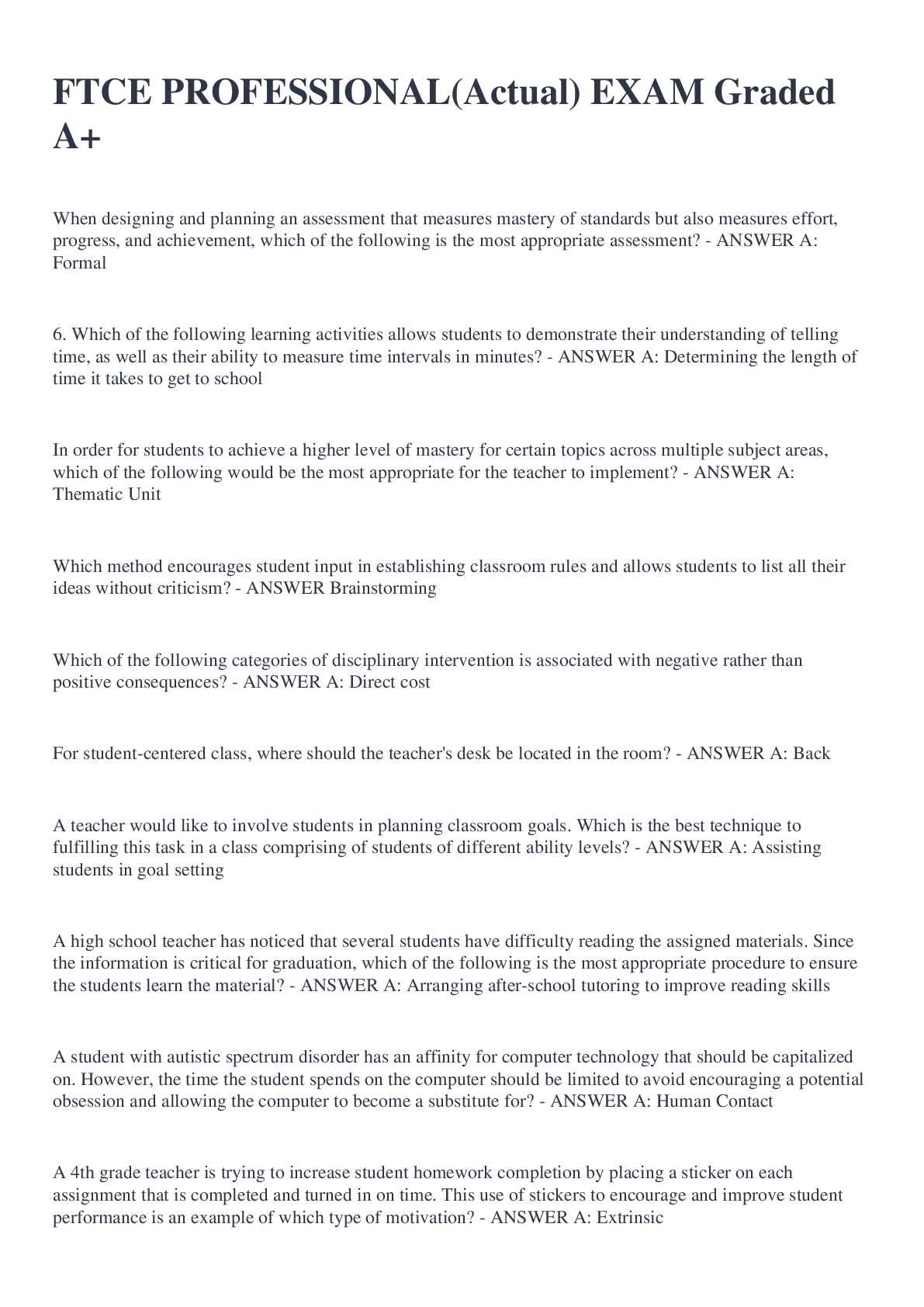
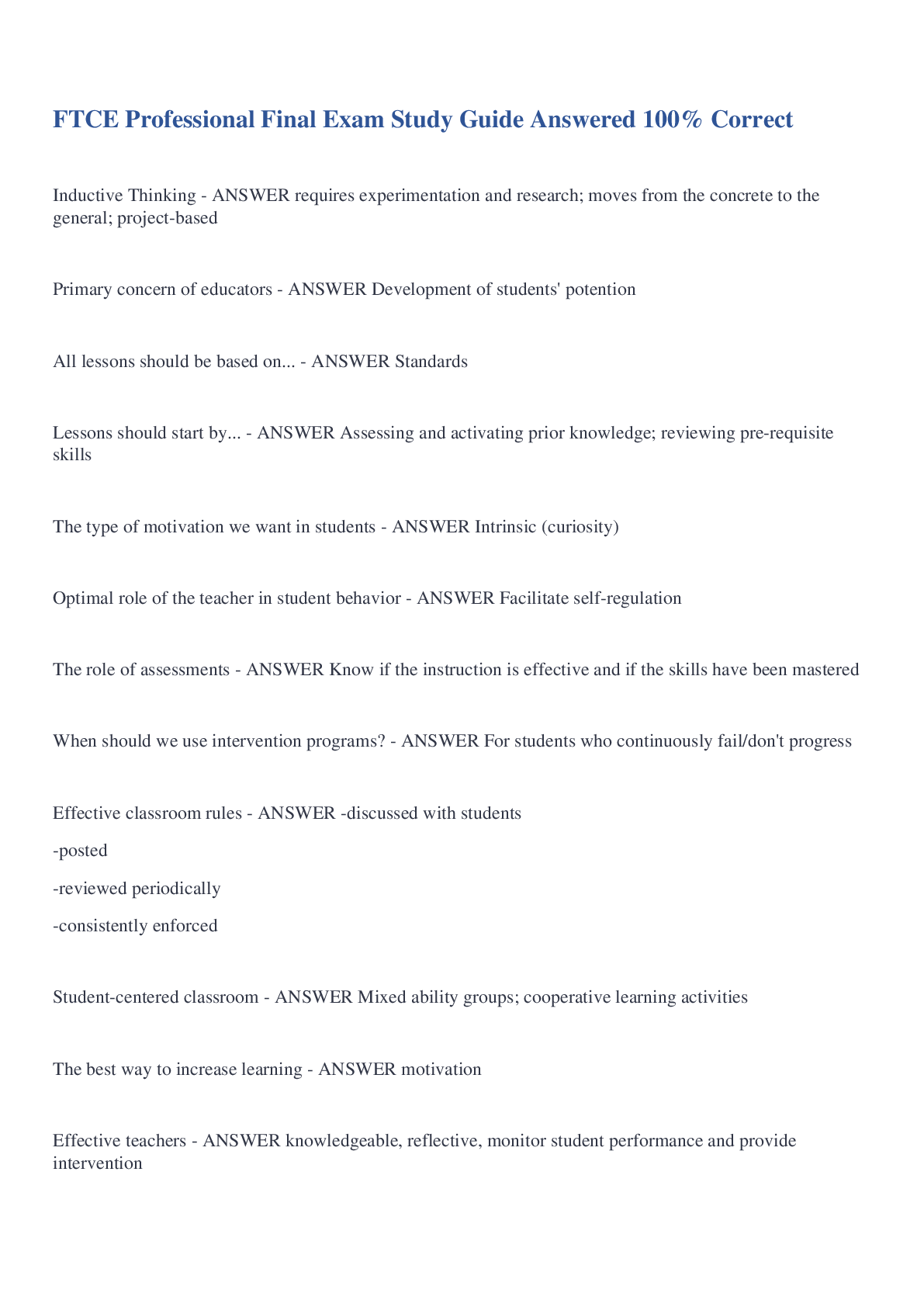
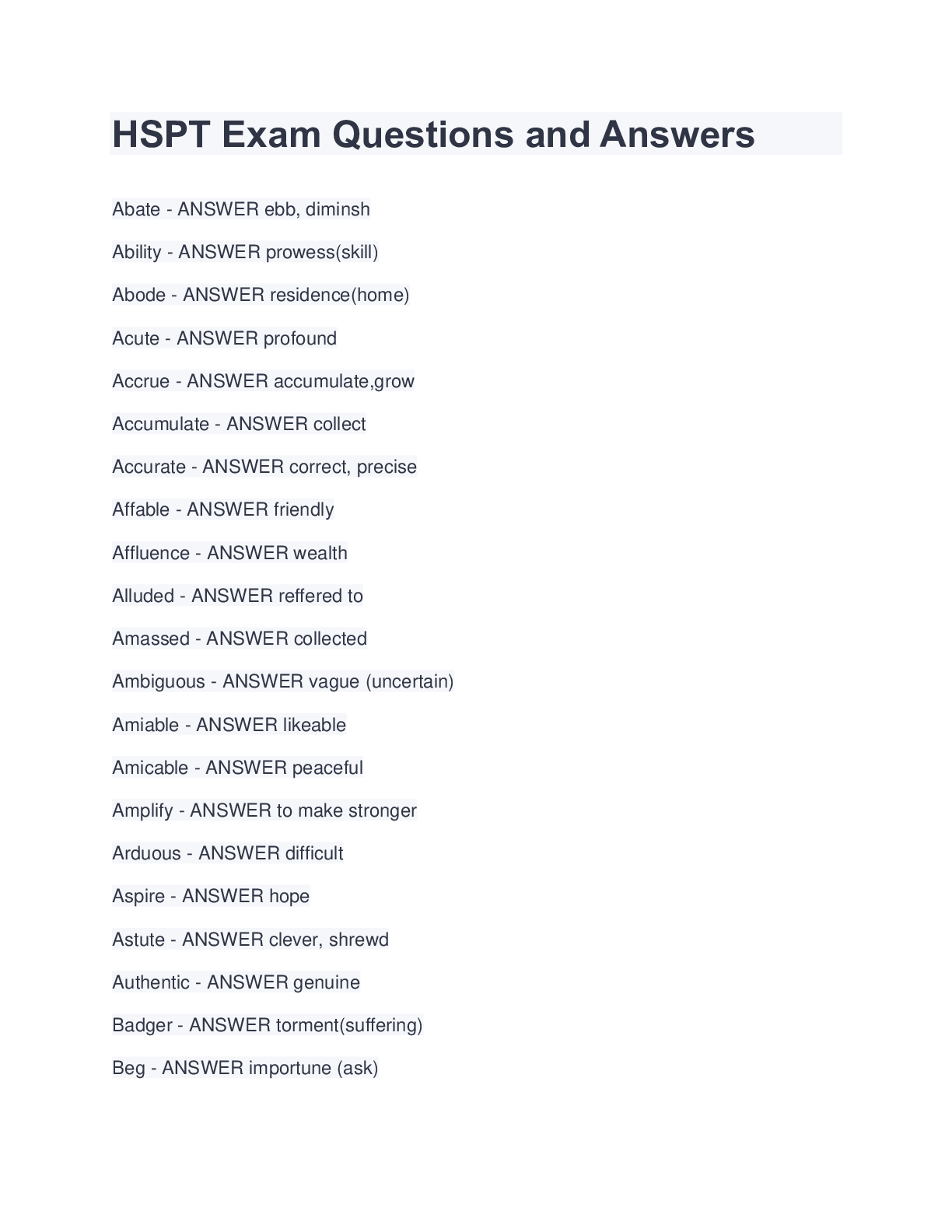
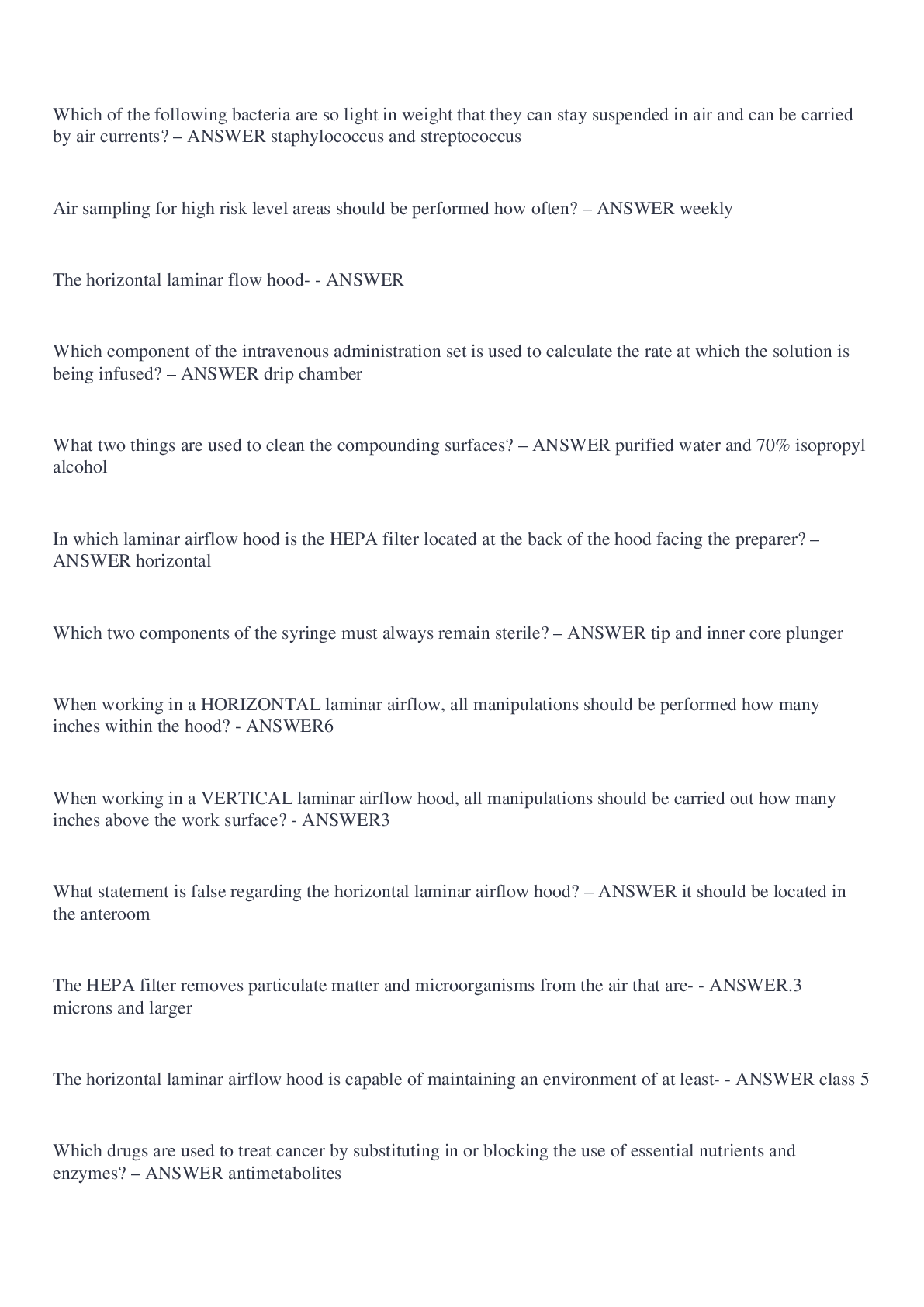
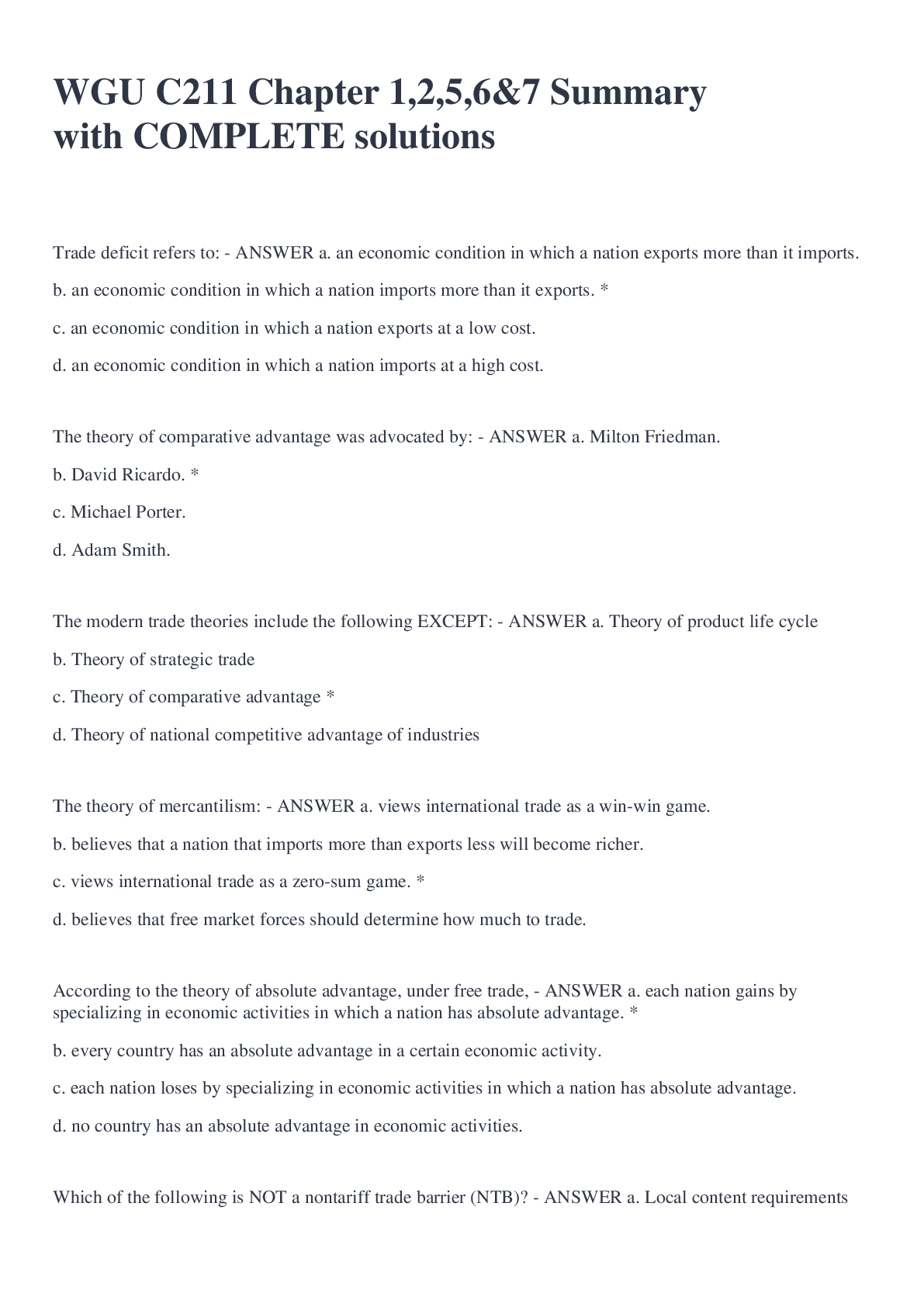
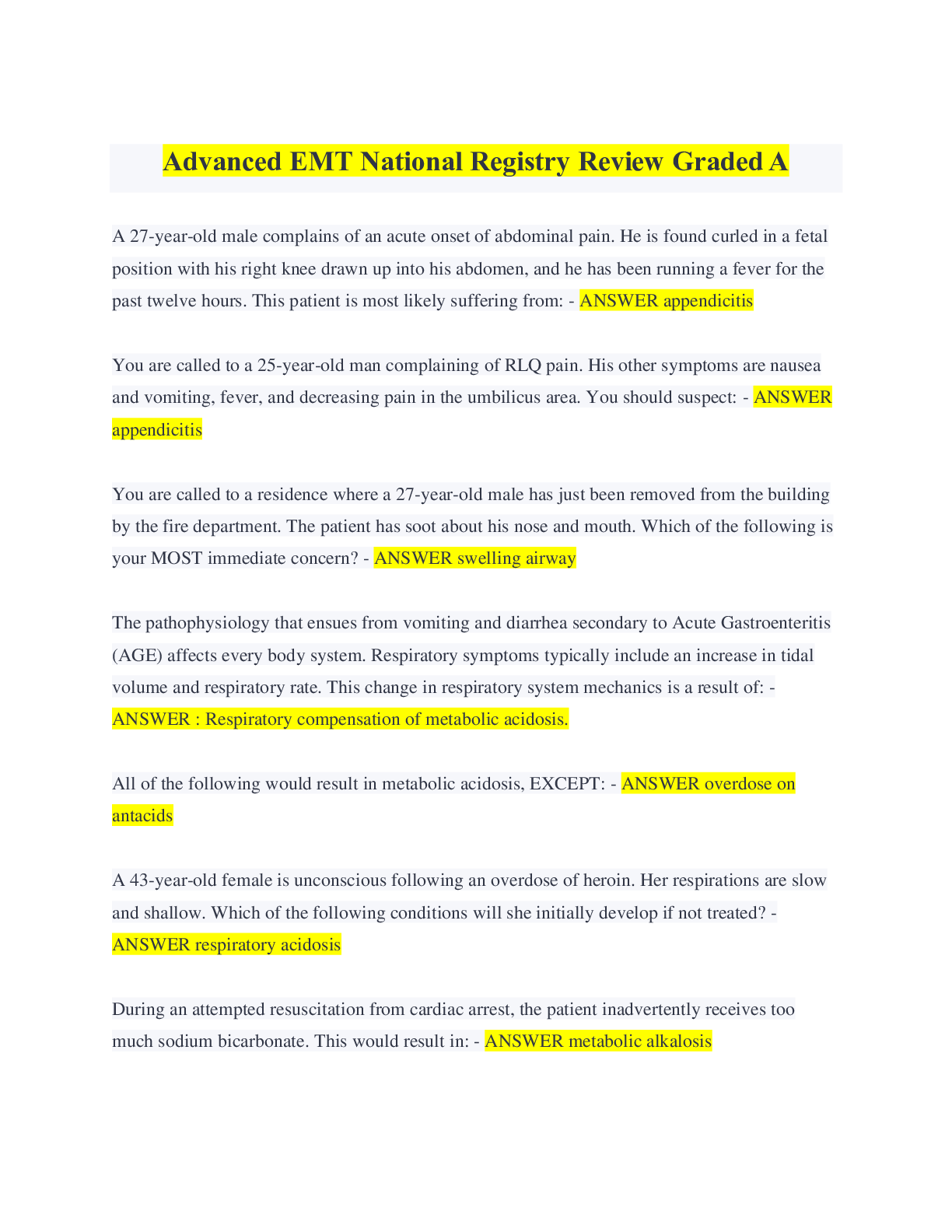
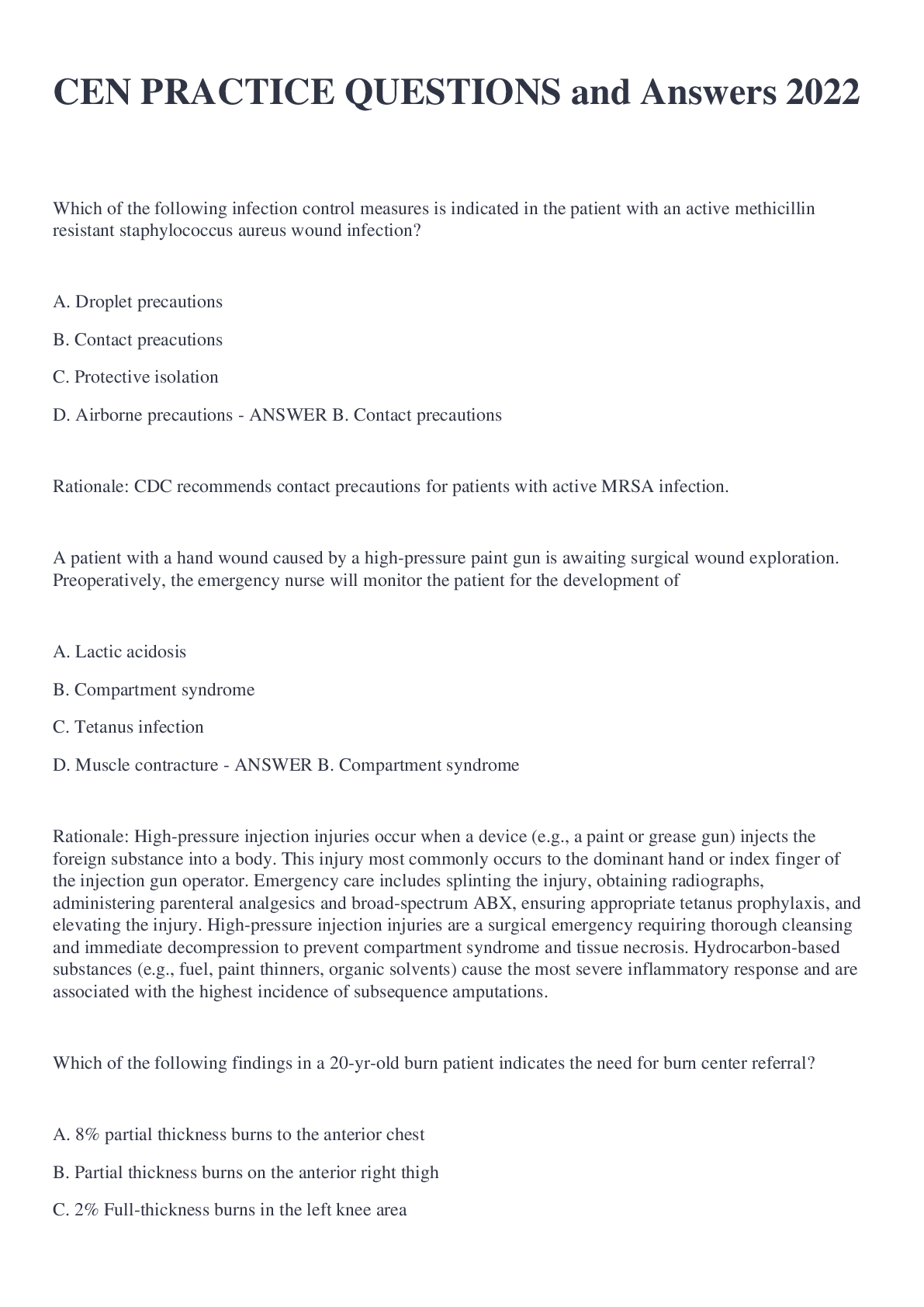
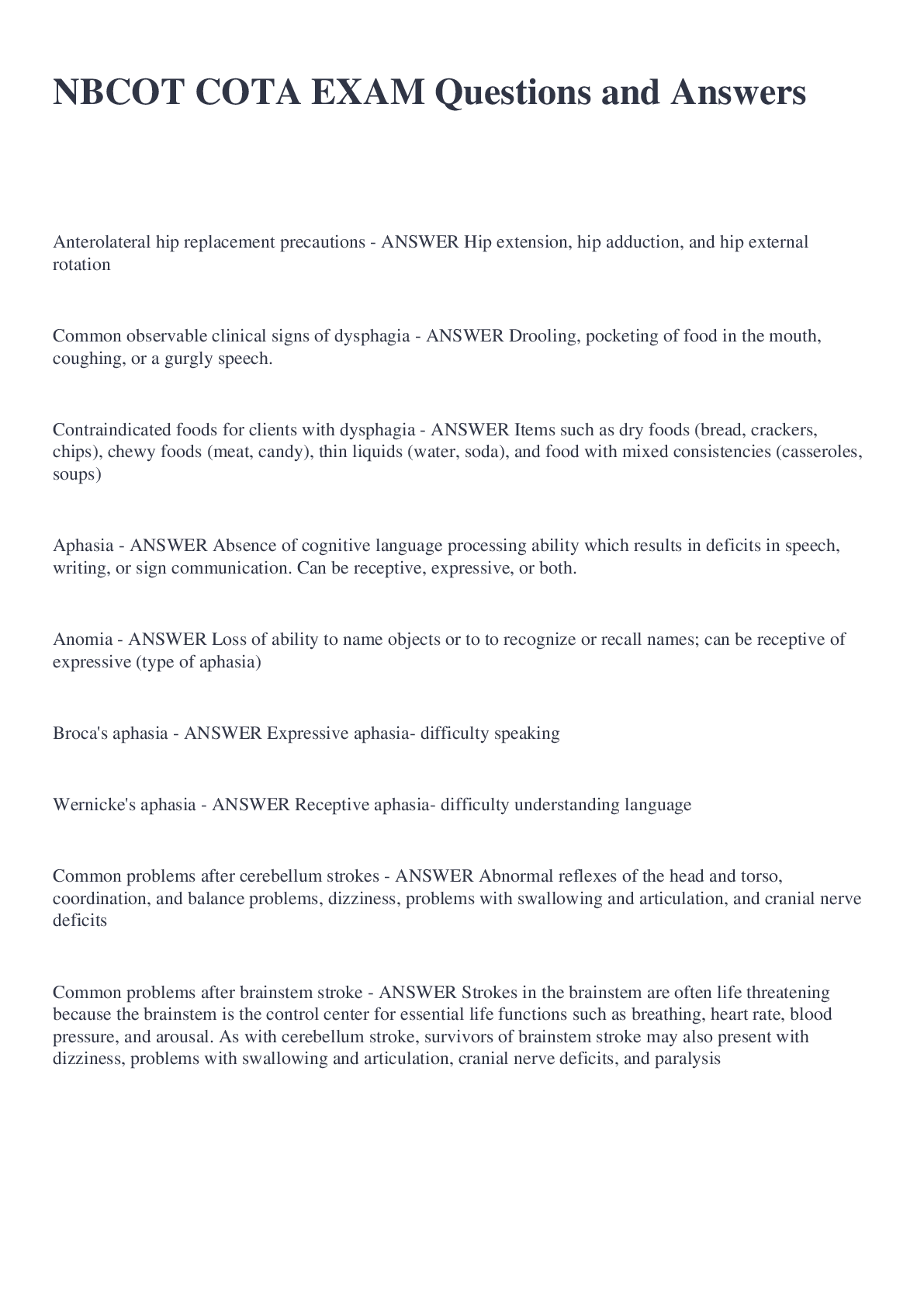
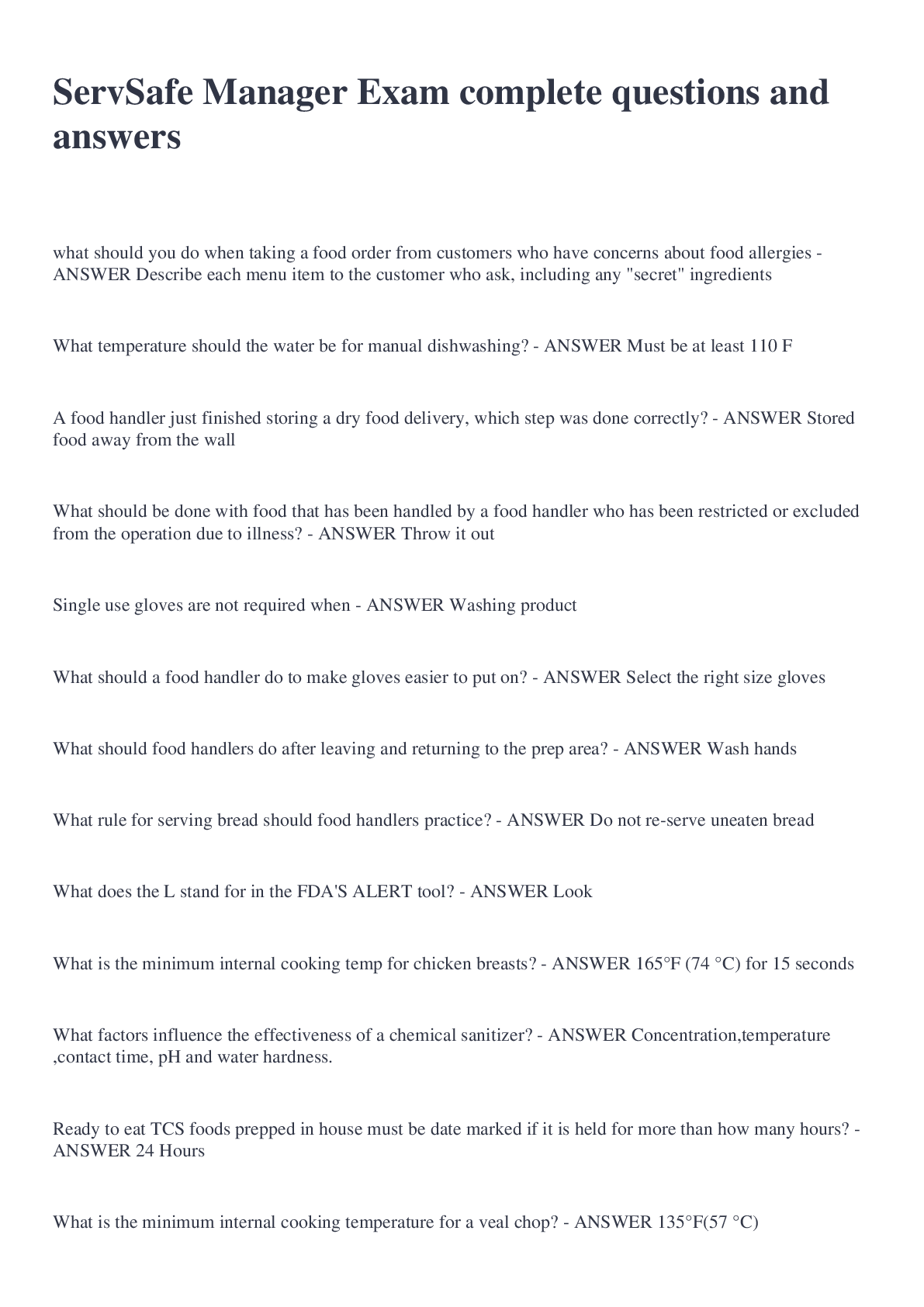
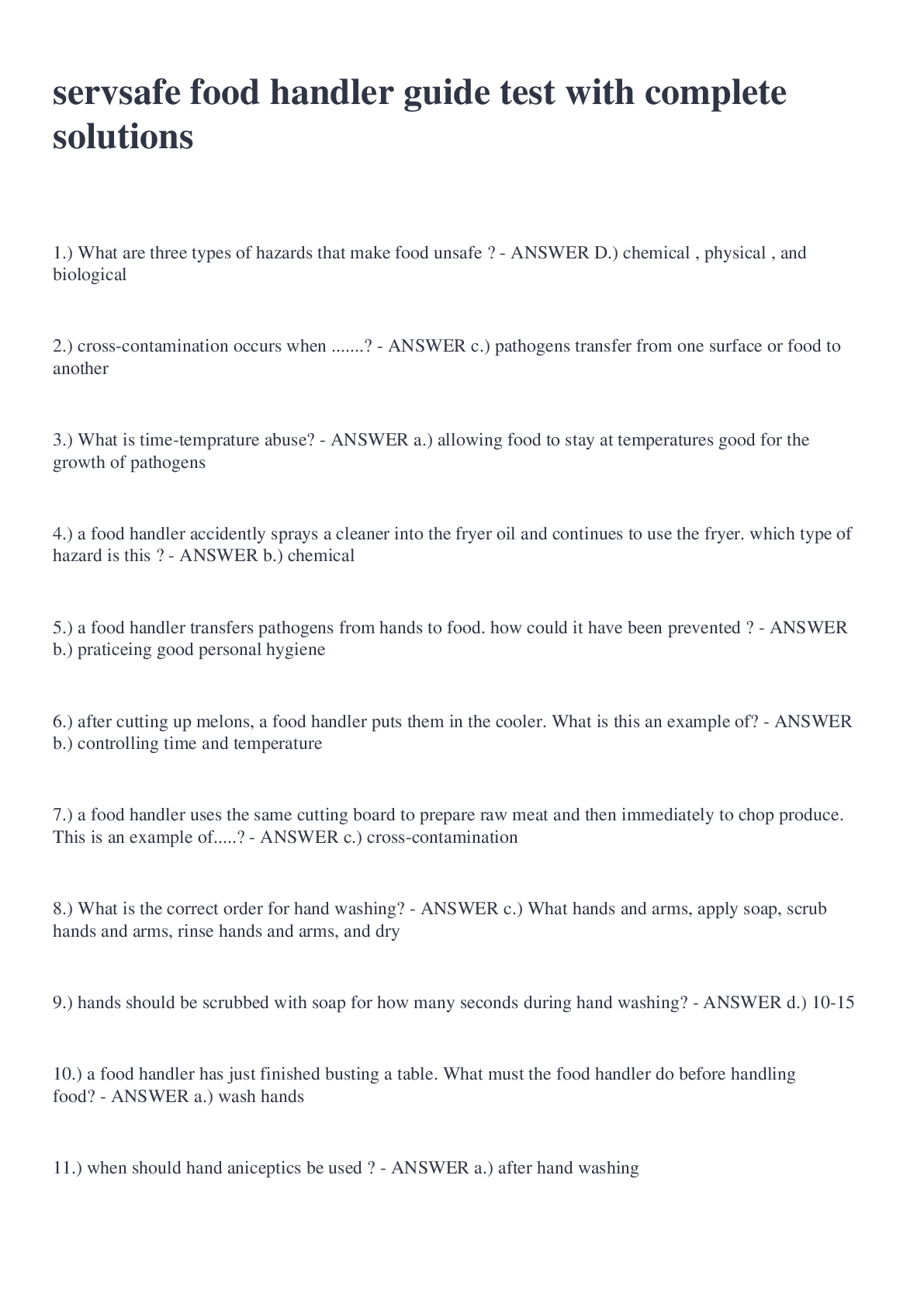
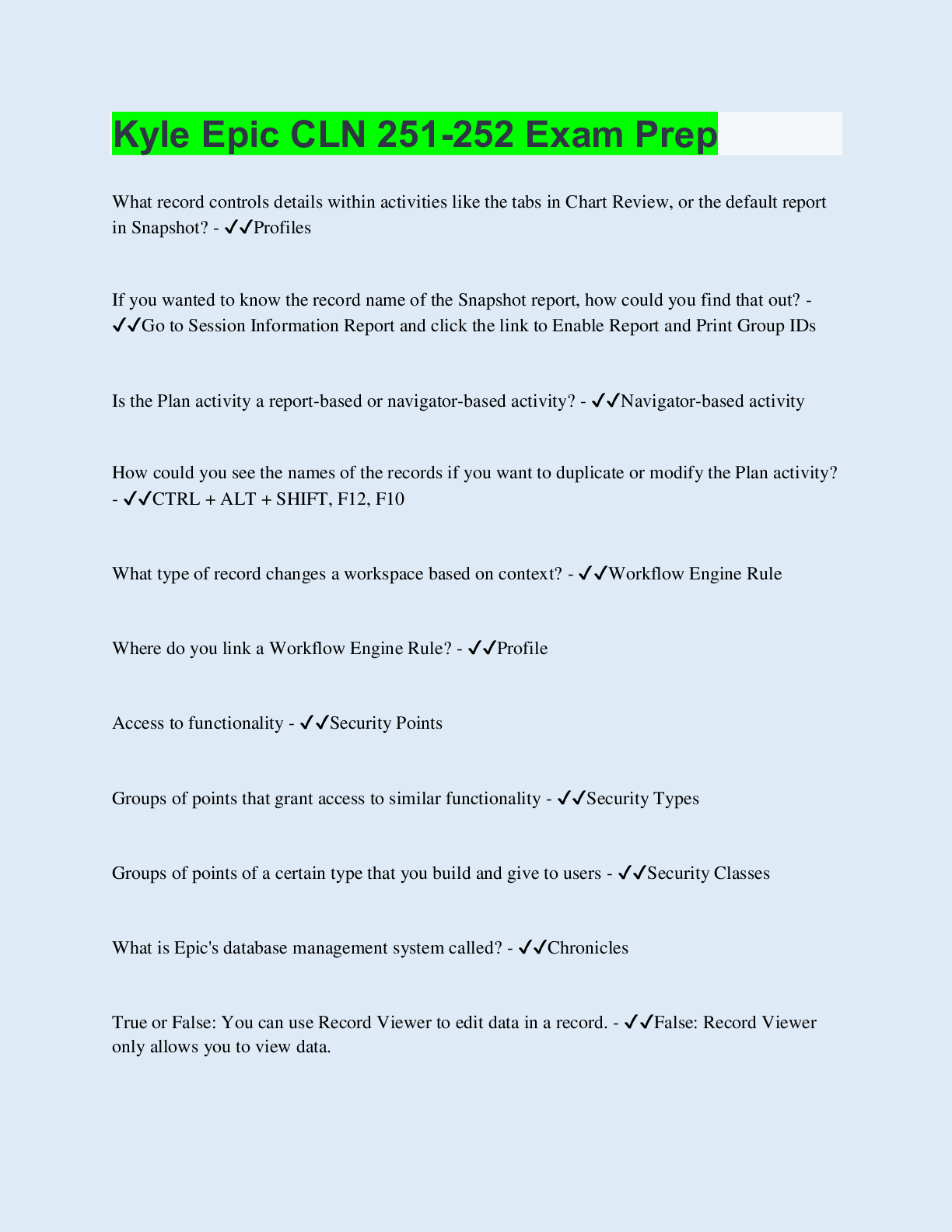
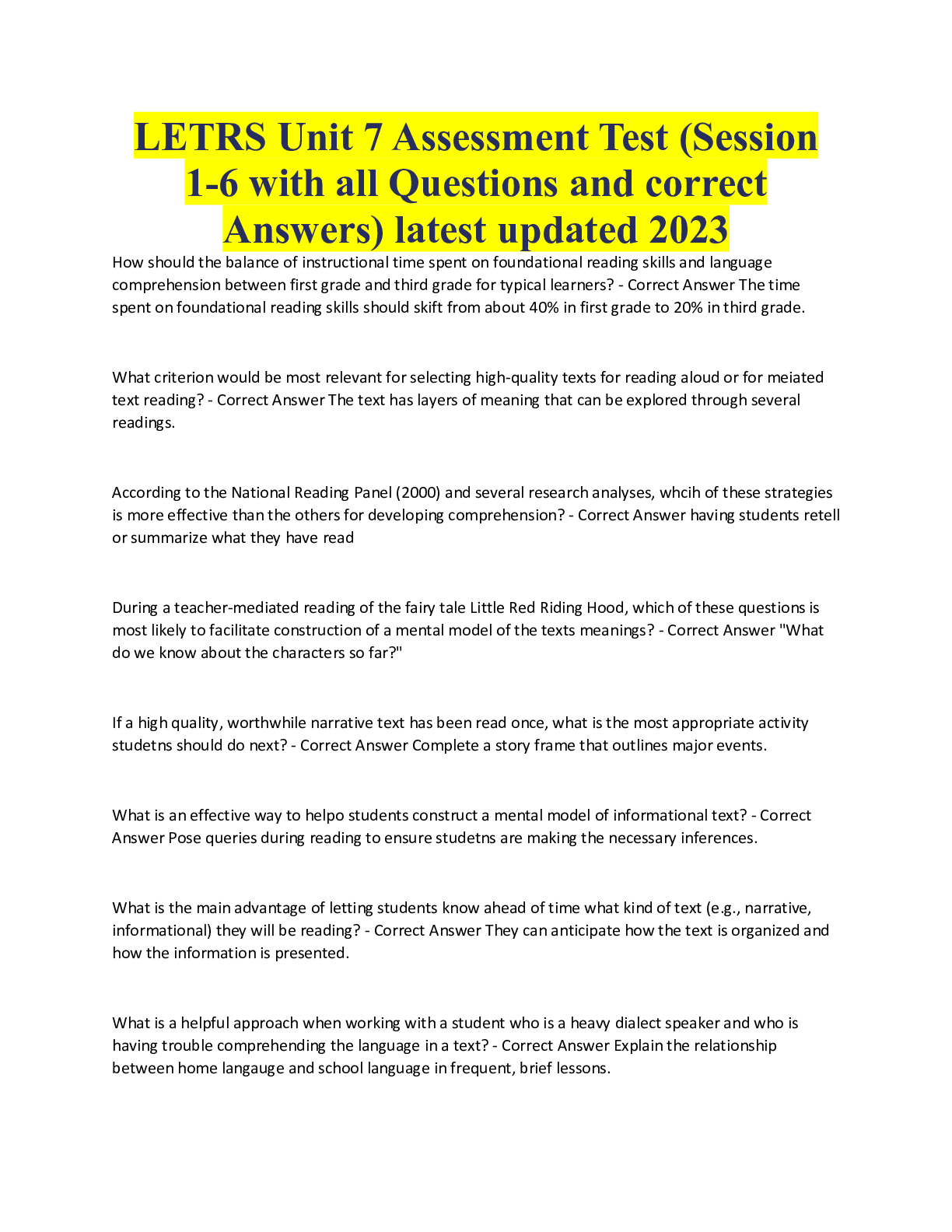
.png)




